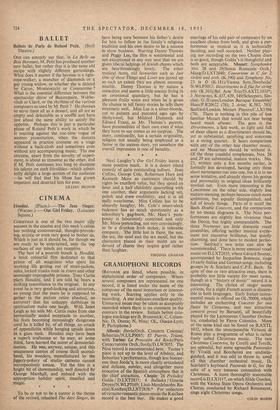GRAMOPHONE RECORDS
(RECORDS are listed, where possible, in alphabetical order of composers. Where several composers are represented on one record, it is listed under the name of the composer of the most important or interest- ing work. Starring applies only to the recording. A star indicates excellent quality. Unstarred issues may be taken as acceptably recorded where there is no comment to the contrary in the review. Initials before cata- logue markings are:B, Brunswick; C, Colum- bia; D, Decca; N, Nixa; OL, Oiseau-Lyre; P, Parlophone.) Albeniz: lberialOreh. Concerts Colonne/ Sebastian/N.ULP9085; El Puerto, Triana, with Tarim: La Procesion del RociolParis Conservatoire Orch./Jorda/D.LW5055. The Nixa record is recommended here. Turina's piece is not up to the level of Albeniz, and Sebastian's performance, though less boister- ous than Jorda's, is more clearly articulated and delicate, subtler, and altogether more evocative of the Spanish atmosphere that is the chief attraction. Chopin: 24 Preludes! Gulda / D.LXT2837; 4 Ballades Ginette Doyen/N.WLP5169; Liszt-Mendelssohn Re- cital/Katchen/D.LXT2838.* For collectors of virtuoso romantic piano music the Katchen record is the best buy. He makes a good marriage of his odd pair of composers by an excellent choice from both, and gives a per- formance as musical as it is technically dazzling, .and well recorded. Neither play- ing nor recording on the two Chopin discs is so good, though Gulda's is thoughtful and both are acceptable. Mozart: Symphonies Nos. 28 and 29/Suisse Romande Orch./ Maag/D.LXT2840; Concertone in C for 2 violins and orch. (K.190) and Symphony No. 23 in D (K.181)/Vienna Sym./Swoboda/ N.WLP5013; Divertimento in E flat for string trio (K.563)/Bel Arte Trio/D.AXTL1031*; 3 Nocturnes, K.437, 439, 549/Scheepers, Sin- clair, G./Evans/London Baroque Ensemble/ Haas/P.R20622 (78); 2 Arias, K.582, 583/ Seefried/London Mozart Players/C.LX1596 (78). There is nothing in this pile of less familiar Mozart that would not bear being heard much oftener. The gem is the Divertimento, a late work, as light and full of sheer charm as a divertimento should be, yet as substantial, satisfying and sonorous as a' string quartet. It bears comparison with any of the other late chamber music, and no Mozartian should be without it. Of the three youthful symphonies, Nos. 28 and 29 are substantial, mature works. No. 23, written only a few months earlier, is formally less developed, having only three short movements run into one, but it is in no sense tentative, and already shows his genius and personality in original ideas brilliantly worked out. Even more interesting is the Concertone on the other side, slightly less mature-seeming, perhaps because much more ambitious, but equally distinguished, and full of lovely things. Parts of it recall the Bach Double Concerto, and the comparison by no means disgraces it. The Nixa per- formances are slightly less vivacious than the Decca, but highly commendable. The three Nocturnes are little domestic vocal ensembles, offering neither musical excite- ment nor executive brilliance, but quietly charming, and done here to modest perfec- tion. Seefried's two 'arias can also be recommended. There is more unusual vocal music on D.LXT2835, where Gerard Souzay, accompanied by Jacqueline Bonneau, sings 19 early Italian and German songs, including groups by A. Scarlatti and C.P.E. Bach. In spite of one or two attractive ones, there is probably too little variety for most tastes, though as a "history of music" record it is interesting. The choice of singer seems curious, for a slight French accent is discern- ible in both languages. Early Italian instru- mental music is offered on OL.50008, which includes an enchanting Concerto for two flutes by Cimarosa, and two attractive concerti grossi by Barsahti, all beautifully played by the Lamoureux Chamber Orches- tra, conducted by Pierre Colombo. More of the same kind can be found on B.AXTL 1032, where the unsurpassable Virtuosi di Roma play a programme of what is rather freely called Christmas music. The two Christmas Concertos, by Corelli and Torelli, are splendid, but some agreeable Pastorales by Vivaldi and Boccherini are undistin- guished, and it was odd to throw in, amid all this chamber orchestral music, D. Scarlatti's keyboard Pastorale in G, for the sake of a very tenuous connection with Christmas. A more thoroughly seasonable record is D.LX3117, on which Hilde Gueden, with the Vienna State Opera Orchestra and Chorus, conducted by Richard Rossmayer, sings eight Christmas songs, COLIN MASON










































 Previous page
Previous page